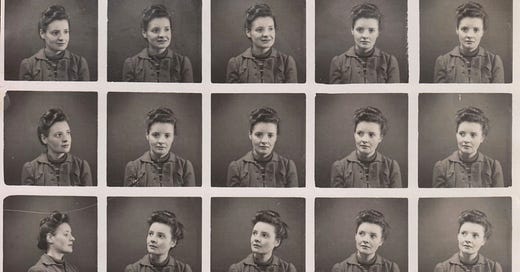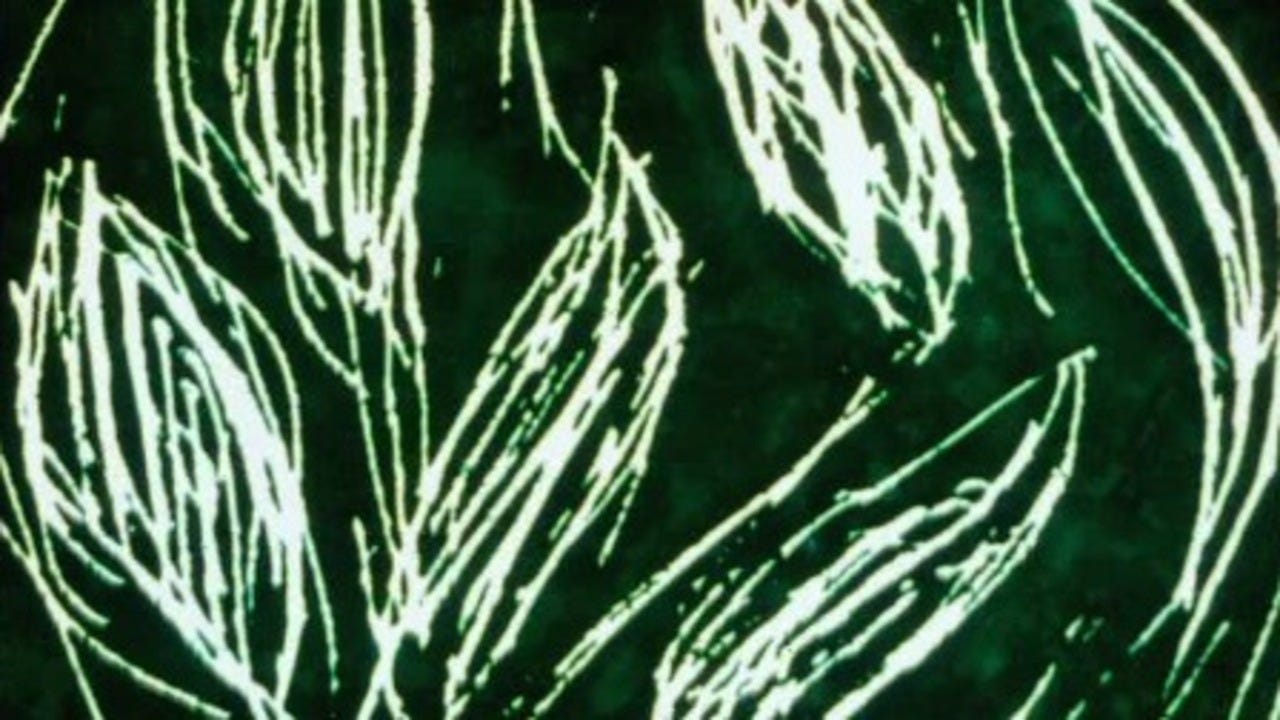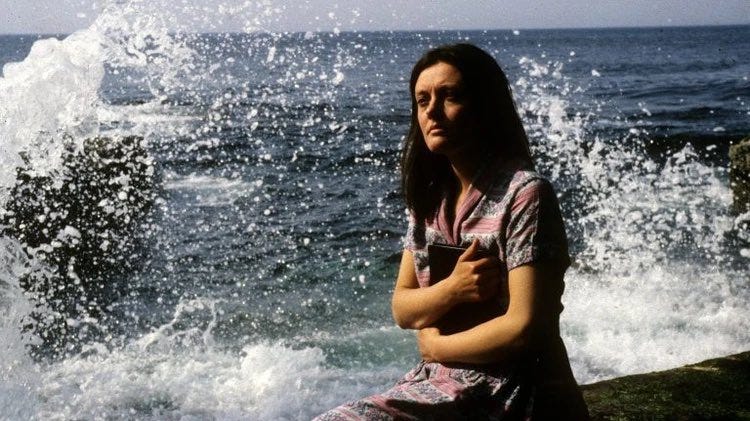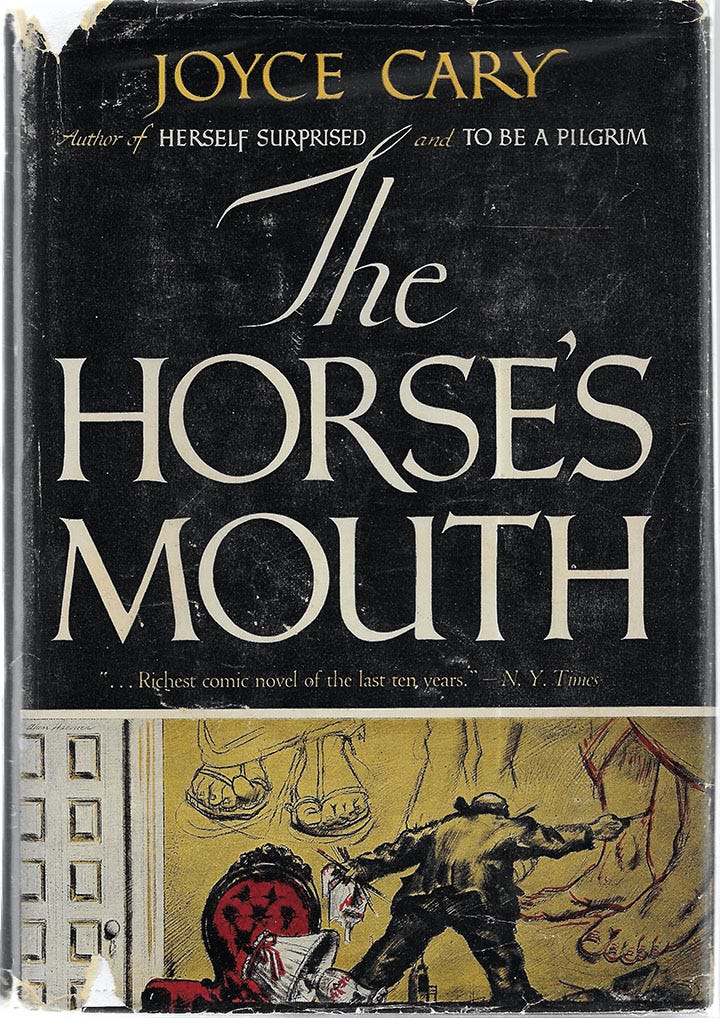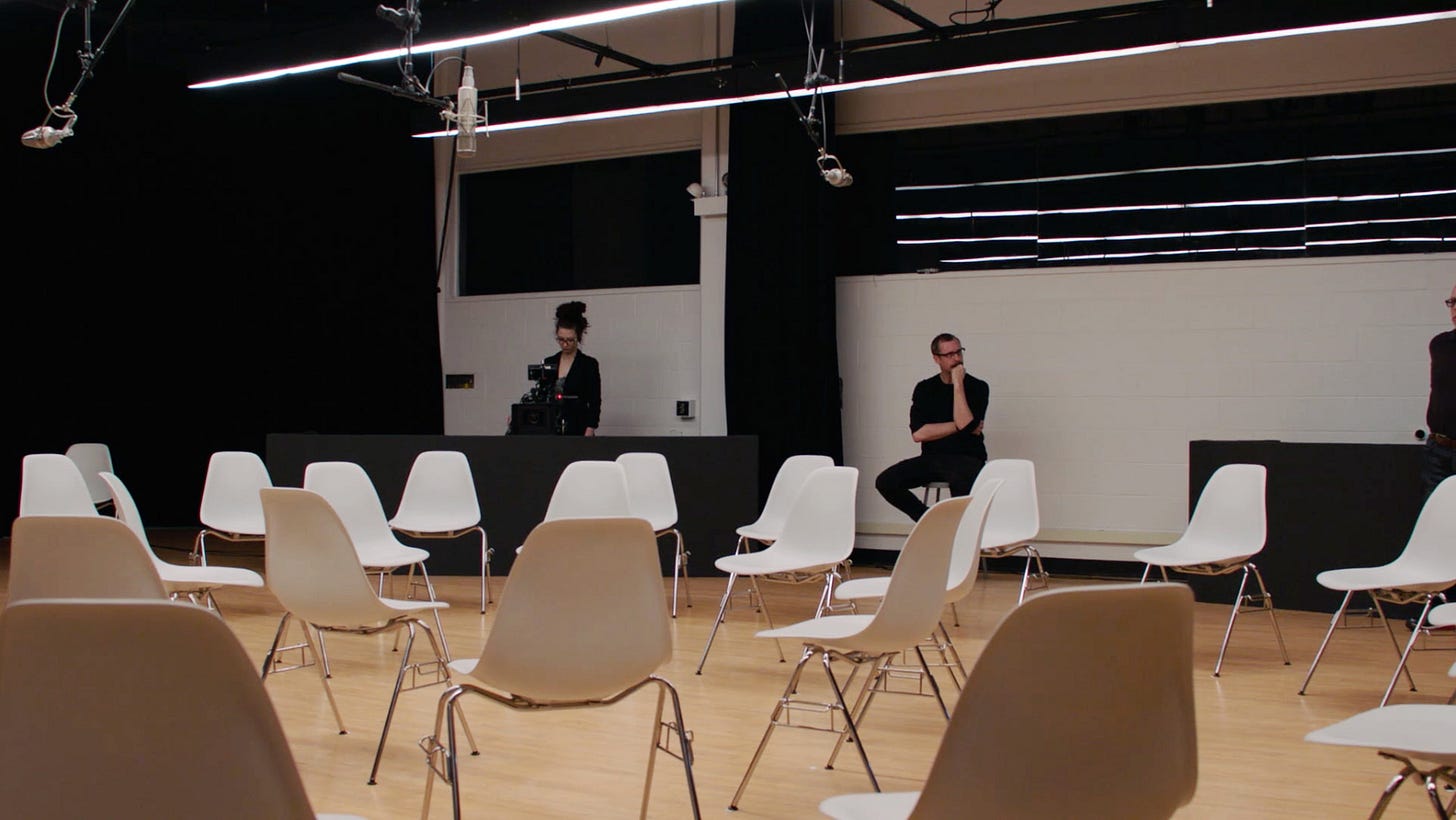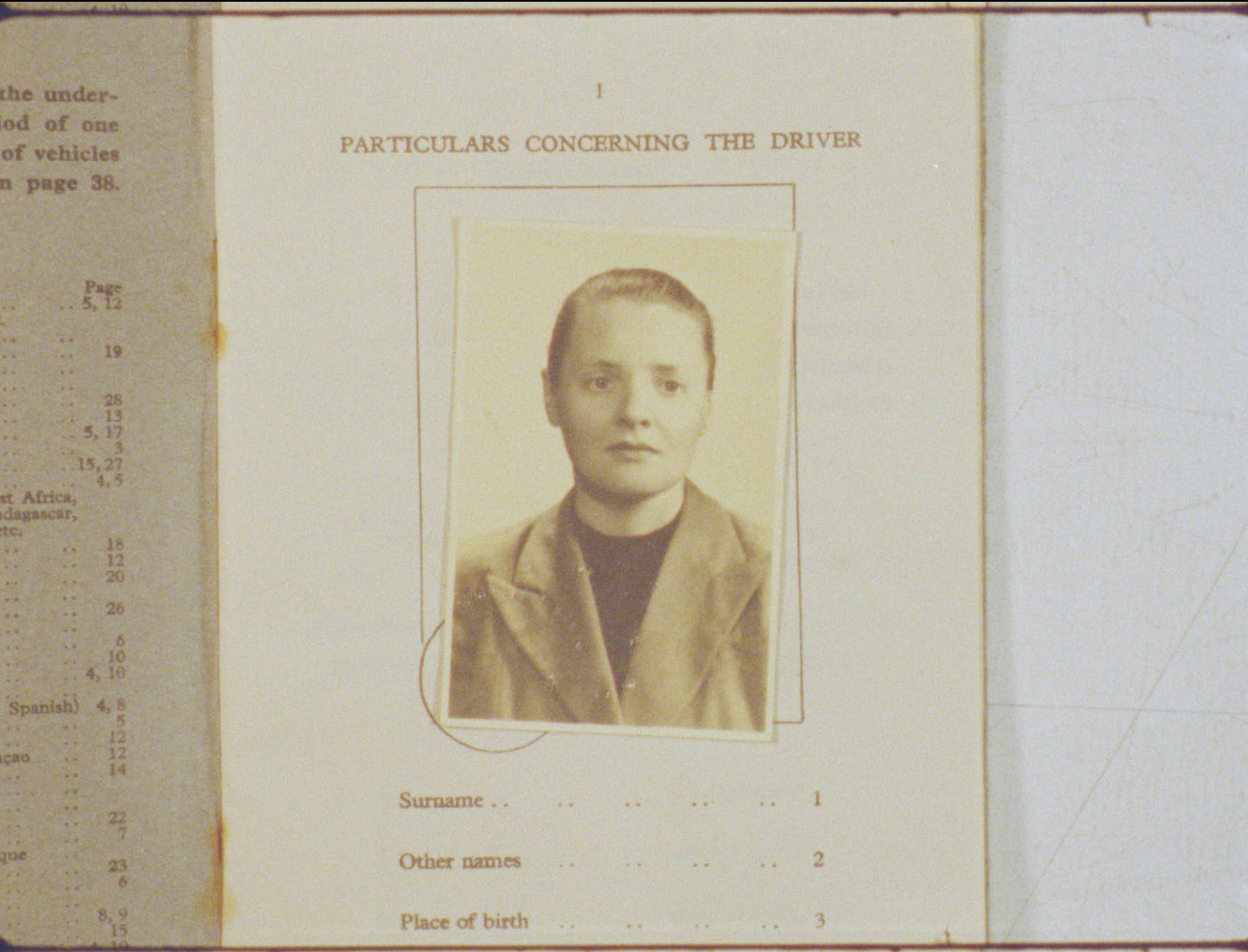
Being in a Place, Luke Fowler’s portrait of the filmmaker Margaret Tait, had its New York premiere at the Museum of Modern Art last week; part of Doc Fortnight 2023, organized by Sophie Cavoulacos and Julian Ross. Following the screening, Fowler remarked that it felt incongruous to see Tait’s work on a big screen in Manhattan. Her films were mostly shot on the Orkney archipelago in Scotland, where she grew up. She worked on 16mm film, using a clockwork Bolex camera, depicting the landscape and the rhythms of Orcadian life. For Fowler, Orkney is a place out of time. By comparison, New York feels like Blade Runner. He said that there are people living on the islands who have never been to the mainland, then joked that this is not so different to some people in Manhattan.
Tait’s films are allusive and braided tightly with the poetry she wrote. They’re also hard to place a date on. MoMA paired Fowler’s feature with Tait’s short Garden Pieces. It’s series of loose, rotating shots, the frame thick with greenery, strafed by low sunlight and a stern breeze. The camera picks up weeds and flowers, the front end of an old car, and well-used pieces of furniture scattered around the garden. A jet-black cat prowls the undergrowth. On the soundtrack are spare and unsettling piano phrases, the kind of music you might hear on a mid-century European art house movie. Not much happens in Garden Pieces: it’s a mood not a manifesto. It looks as if it could’ve been produced in the 1950s, when Tait first began making and showing films. Or it might have been made during the 1970s, when her work was circulating through London FilmMakers’ Co-Op distribution catalogues, being screened in the company of younger experimental film artists. But Garden Pieces was shot in 1998, a year before she died. Tait made ordinary subjects appear timeless.
People either seem to know a great deal about her, or nothing at all. (During the MoMA Q&A session, one audience member—there’s always a show-off at these things—asked for a straw-poll of who had heard of Tait and the Orkney Islands before the screening. About half the crowd raised their hands. A few might have seen the museum’s 2005 retrospective of her films, organized by Peter Todd. The man in the audience seemed surprised. Perhaps he’d never left Manhattan.) Tait was born in 1918 and studied medicine at Edinburgh University. During World War Two she served in the Royal Army Medical Corps in India, Sri Lanka and Malaysia. After the war she enrolled in a language school in Perugia, Italy, but in 1950 moved to Rome where she spent two years studying film at the Centro Sperimentale di Photographia. “It was a good time to be there,” says Tait at the start of Being in a Place. “There was a lot going on and we had the chance of following the work of directors working in Rome at that time. In fact, some of them used to turn up at the Centro […] I remember one day Rossellini and Ingrid Bergman appearing to show us Stromboli, which was just ready for release […] I worked with fellow students at the Centro making short films there and when I returned to Scotland I continued making short films by myself.”
She moved back to Edinburgh, living frugally and renting a small studio on Rose Street. There she wrote poetry and started a production company, Ancona Films. Tait got to know a group of local writers, the ‘Rose Street poets.’ It was a macho scene, but she would later shoot a playful film portrait of one of its key figures, Hugh MacDiarmid, then in his seventies, filmed balancing along walls and street curbs like a small boy.
In the summer of 1954 she organized her own DIY film festival in her workrooms. “Any evening that suits you,” read the flyer, “at 91 Rose Street, up two flights of the stone stairs and follow the smell of coffee.” Here she screened Portrait of Ga, an intimate, beautiful film of her mother, along with work by friends from Italy and the US. She described the experience in largely positive terms. “Some of the most appreciative members of our audiences were practising artists in other fields – architects, musicians, a few painters, one poet,” she wrote. Local children came, as did curious teenagers, dressed teddy boy style. “There were only very few who had the upside-down sophisticated state of mind which I associate with a certain type of suburban film society member, hack reporters, and the sort of smart alec who must always be in the know and in the fashion. […] They said they were ‘hoping for something more experimental’ or ‘WHY did I make these films?’ as if they couldn’t understand anyone going to any trouble to make a film that is quite lucid. […] It is as if they had difficulty in understanding anything straightforward and clear.”
The 1960s saw her return to Orkney. “Speak the things you know,” Tait said, “make films about what you really feel.” There she evolved her avant-garde vernacular style, training her camera on the rugged, island landscape, on friends and family. She shot handheld, using the camera as an extension of her body. (I used to have a Bolex not dissimilar to Tait’s. If you’ve ever tried holding one of those cameras for any length of time, you’ll know how quickly your arms will start to ache. It changes how you shoot.) The films have a diaristic quality, reminiscent of Jonas Mekas, although in Orkney there were few opportunities to visually name-drop famous artists and musicians, as Mekas did in his New York film diaries.
Tait brought animation into her work—Colour Poems from 1974 is a good example—scratching and painting directly onto the celluloid, like Len Lye did in the 1930s with his films for the GPO (General Post Office). Titles were made by hand, painted on wood or stone, or spelled in cut-out letters arranged on the ground. Tait rarely appeared in her films, although she used her voice to narrate or read her poems. (There’s a brief cameo of her in The Leaden Echo and The Golden Echo, from 1955, a gorgeous setting of a poem by Gerard Manley Hopkins.) She spoke in slow, carefully enunciated cadences. Background audio—domestic clattering, street noises, wind—can frequently be heard in the background. Sound was treated separately, rarely synced to the images. Almost all her films were self-financed—she struggled to get funding, despite being the subject of two British television documentaries, despite her work showing at film festivals at home and abroad—and travelling to dubbing sessions was often too costly. Instead, she would send instructions to the production facility detailing which pieces of sound or music where to be placed where. (Fowler likens these notes to a doctor writing prescriptions.) In 1992, aged 74, she released her first and only feature film, Blue Black Permanent, starring Celia Imrie, Jack Shepherd and Gerda Stevenson. At the 1993 BAFTAs, Stevenson won the award for Best Actress, and the movie was nominated for Best Film. Tait’s ideas for the film originated as far back as the 1950s. Who knows how her films would have evolved if she’d had that opportunity earlier in life.
Being in a Place is shot in Orkney. There’s a nice double meaning to the title: ‘being’ as in a living thing, or ‘being’ as in an experience. It’s based on Heartlandscape, an unrealized project Tait proposed for Channel Four, an experimental travelogue that was to trace a heart shape around Orkney. Fowler shoots handheld, snapping together short fragmentary sequences of local people—the work of fishing and farming, of shepherding oil from the North Sea—and putting these sequences in conversation with Tait’s film work. There are shots of low hills and rain-slicked roads, often layered as if to suggest likenesses and circularities. He switches between his own hand-made titles and Tait’s. Fowler echoes her techniques, speaks her film dialect, which in the first minutes of the movie can make it hard to distinguish his footage from her own, but once the eye settles in, it becomes easier to see a delicate and respectful distinction he makes between their work—she didn’t like her films being extracted or edited for documentary use.
For all its contemplative imagery of Orkney’s wide-open spaces, Being in a Place has a busy, sparky rhythm. This is partly dictated by its extraordinary source material, a ‘fugitive archive’ that was found in the garden shed at the house Tait shared with her partner, Alex Pirie. Recently restored, the haul included editing offcuts, test shots, sketches, rushes and alternative cuts; tiny fragments and little bursts of energy that weren’t thought worth keeping for the official Tait archive in the National Library of Scotland. Fowler combined these with rushes from an unfinished documentary on Tait by Margaret Williams, and audio from the Orkney Library and Archive. These are ways around making incisions into Tait’s films that she may have disliked; ways, also, of reflecting how she recycled her own images and footage.
The film is filled with close-ups on her notebook pages, just long enough to give a sense of Tait’s working methods, her budgets and attempts to get her work seen. Fowler keeps flash frames, tape sounds, pops, bleeps and clunks, reminding you how physical the film is. The sound is non-sync, composed of tufts of conversation—information about Tait, Orcadian life—and passing electronic tones composed by Lionel Marchetti. We hear passages from a beautiful, valedictory piobroch—a traditional form for bagpipe—and we hear wind and water.
Fowler has no interest in giving a straightforward account of his subject. Being in a Place instead directs attention. He draws the eye to Tait’s methods and to the ways people affect the landscape in which they live. You can feel the grind and frustration and enchantment of making single-person films, of being ahead of your time, of not being in London, New York, Paris or any other professionally useful place. It’s easy to sling words such as ‘gentle’ or ‘poetic’ when describing Tait’s films, to get woo-woo about the Scottish landscape and the quiet power of the domestic. But Being in a Place left me with a sense of Tait as a hardcore artist, autonomous, completely committed to her imagination and singular way of making work.
There is a scene at the end of Fowler’s film that shows a woman stood outside a London cinema. The sun is bright but the cinema and the woman are in shadow. We hear Tait’s voice. “Can’t think of any British directors who really sort of touch one.” She lived in a remote part of the world—making cinema in shadow, you could say—but her outlook was broad. Her influences included Luis Buñuel, Yasujirō Ozu, Jean Vigo and Satyajit Ray. She admired Jerry Lewis, Billy Wilder and, of all people, Sam Peckinpah. Film, for Tait, was about poetry, wherever you chose to make it. “There’s a whole world at the foot of the stone if you care to look.”
In her poem ‘Now’, published in 1959, she describes being a child, waiting to watch clover open, “but never saw it / I was too impatient / Or the movement is too subtle / Imperceptible.” She writes how “Cinematographically / I have registered the opening of escholtzia / On an early summer morning / It gave me a sharp awareness of time passing / Of exact qualities and values in the light.” But she didn’t see the flower open, her camera did. “Later, on the film, they seemed to open swiftly / But, at the time, / Although I stared / And felt time not so much moving as being moved in / And felt / A unity of time and place with other times and places.”
RECOMMENDATIONS
—Decca are about to put out a collection of unreleased recordings by the late, great opera singer Jessye Norman. Although it’s being done with the permission of her family, predictably it’s sparked Kafka-Brod debates about the ethics of releasing work an artist didn’t sign-off on during their lifetime. Then again, Norman was a perfectionist. Here she is in 1979 with the Orchestre de la Suisse, conducted by Wolfgang Sawallisch, performing ‘Im Abendrot’ from Richard Strauss’s Vier letzte Lieder, a couple of years before she made her famous recording of it with Kurt Masur and the Gewandhausorchester Leipzig.
—Thank you to my friend, the artist Mick Peter, for sending me this odd little film. Presented by John Lloyd, it begins as a clunky comedy satirizing London media yuppies, then slowly turns into a film about the rise of the graphic novel in the 1980s. Features Neil Gaiman (The Sandman), Dave Gibbons (Watchmen) and others, barely out of short trousers.
—I’m part-way into reading Joyce Cary’s 1944 comic novel The Horse’s Mouth. All I can say so far is: Jesus Christ. It’s narrated by artist and con-artist, Gulley Jimson. He’s a rude, reprehensible, sexist, scurrilous, sordid, sponging, William-Blake-quoting jailbird; career-obsessed and completely, unwaveringly, dedicated to painting and to harrassing his art dealer with anonymous, threatening telephone calls. Gulley is a truly appalling character. Cary’s descriptions of London are over-the-top, sublime. I take no responsibility if you decide to read this.
—Leigh Ledare’s 2017 experimental documentary film The Task is now on Criterion. Two hours of remarkable, excruciating tension.
—In 1970, my grandad was made honorary mayor, for one year, of the town of Rochdale in the north of England. He passed away before Rochdale Art Gallery put itself on the map in the 1980s, showing the kinds of art that spaces in other parts of the country were then ignoring. Alice Correia and Derek Horton have now put together a show that looks back at that decade. I think grandad might’ve approved.
—World of Echo in London have just reissued the dreamy 30-something-year-old, self-titled debut of Movietone, originally released by James Webster and writer Richard King on their Planet Records label. Movietone were Kate Wright, Rachel Brook, Matt Elliott and Matt Jones, part of a still undersung scene in 1990s Bristol that included Flying Saucer Attack and Third Eye Foundation. These days the librarians of pop culture would file Movietone under ‘slowcore.’ Back then, the only ‘core I’d heard of was ‘ardcore rave, and this was in the category of ‘something heard once, by chance, late at night on John Peel, unlikely to be in a record store near you.’

